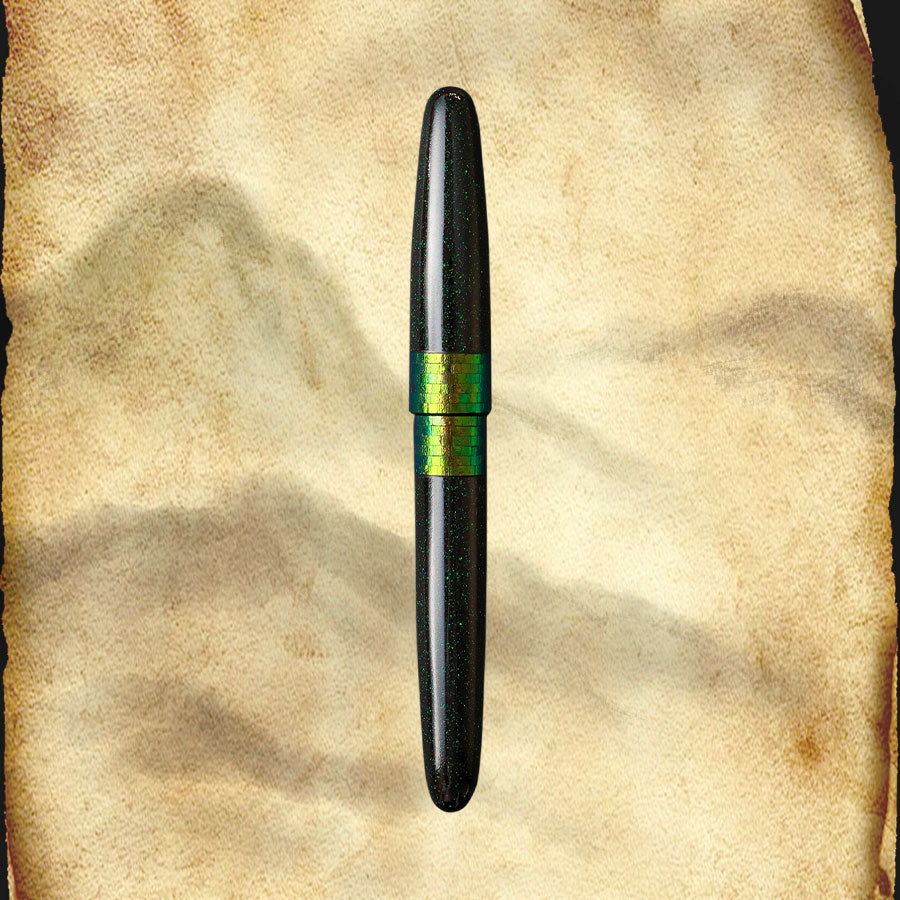
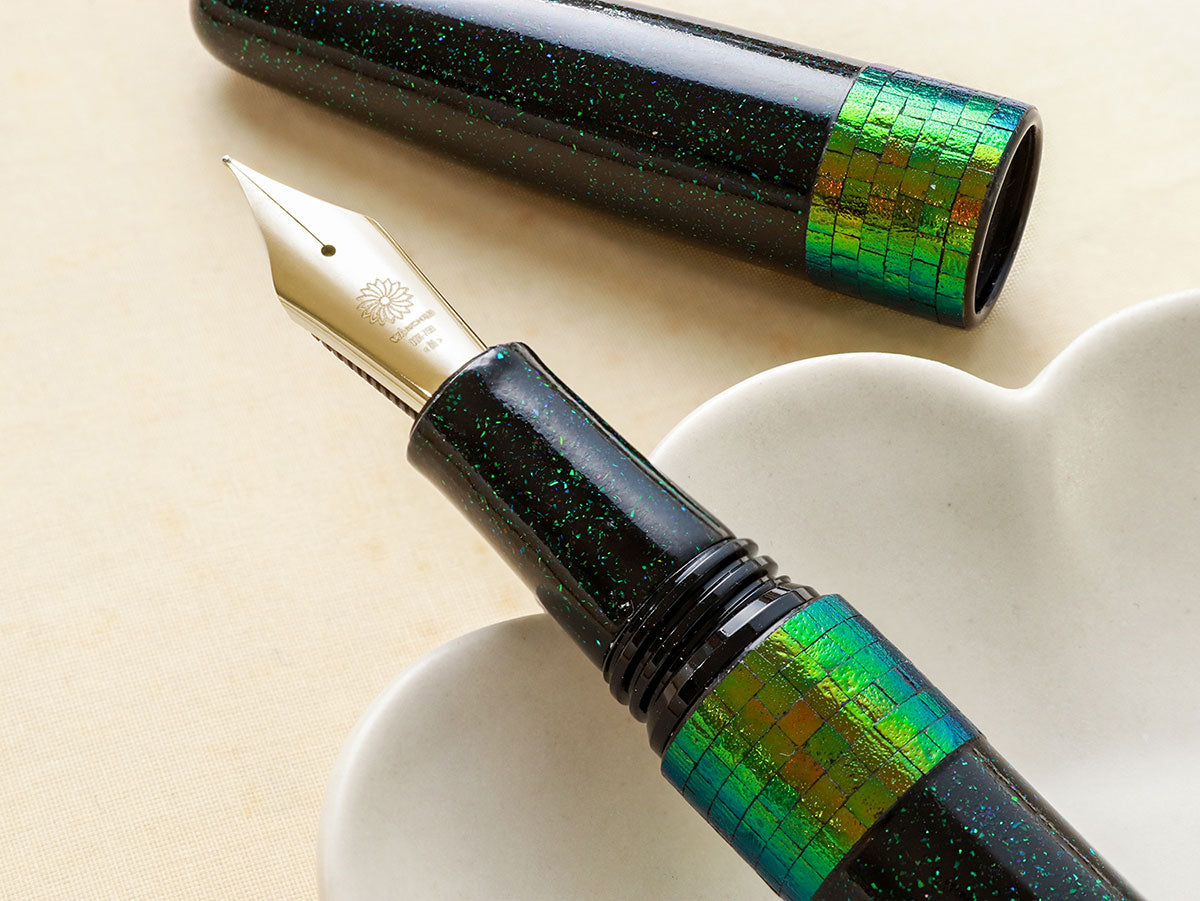


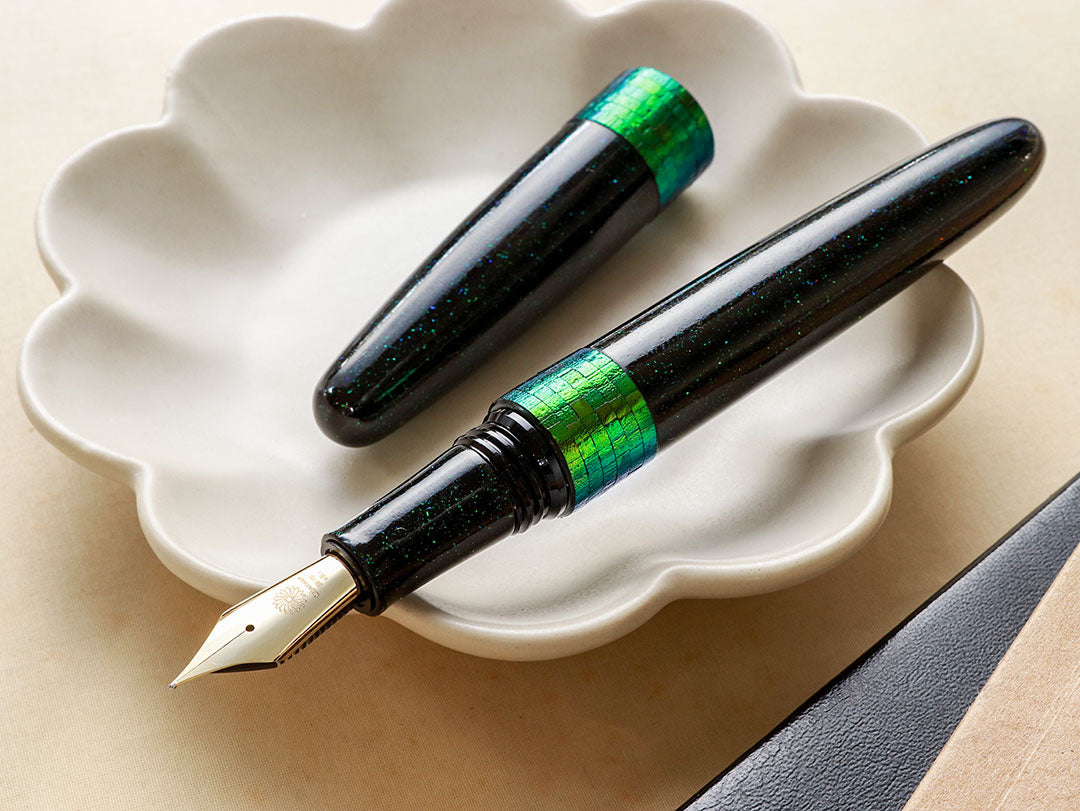

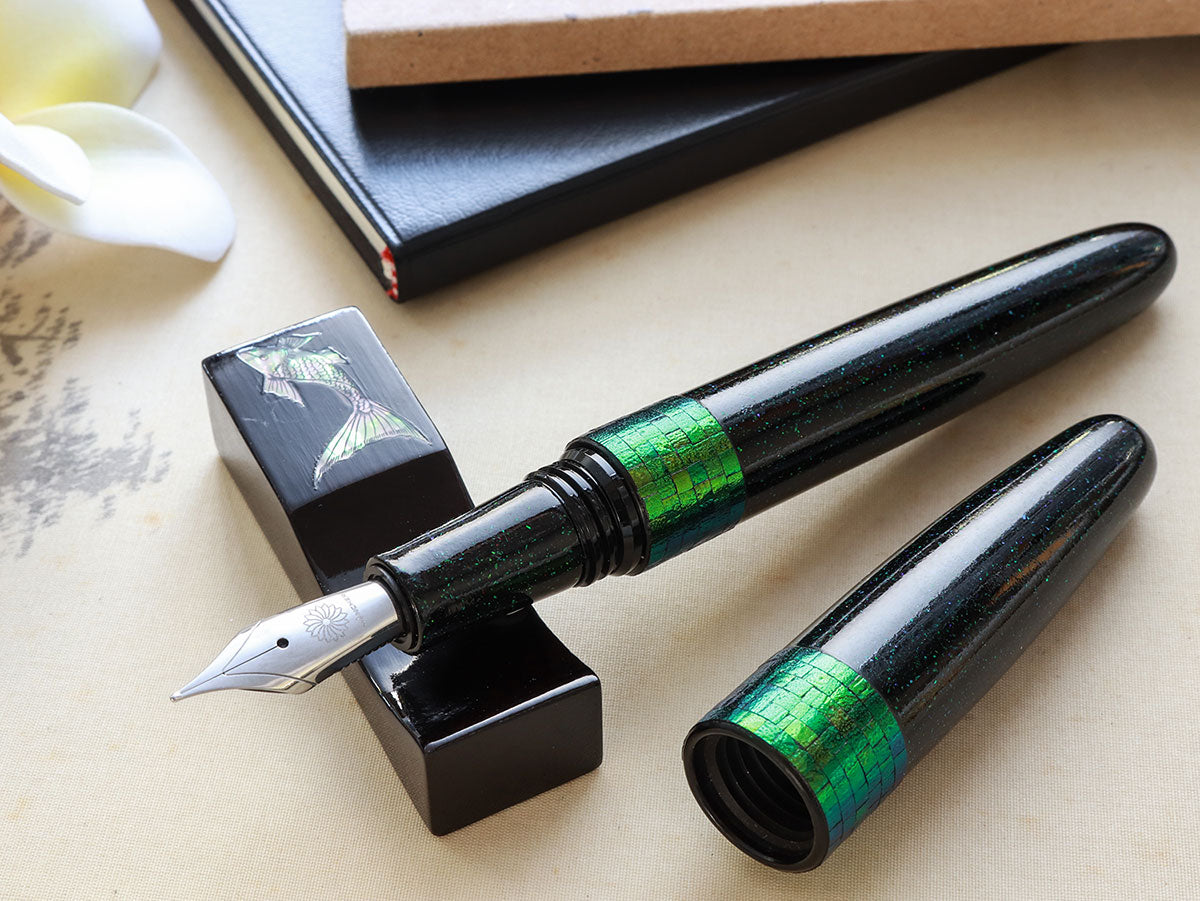
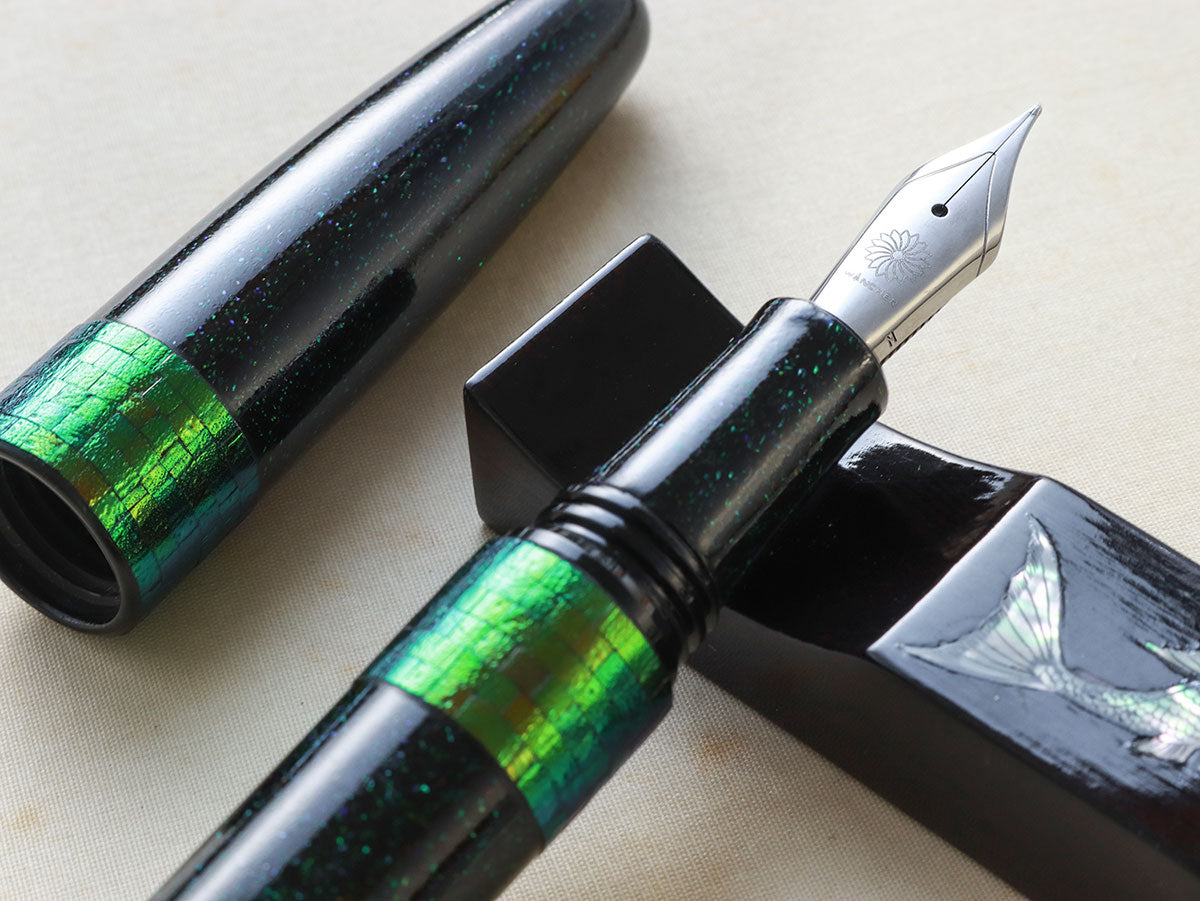

Tamamushi Wing Maki-e
A Japanese cultural treasure from the Asuka era, revived with a technique of Wajima lacquer.
Buy NowTamamushi Wing Maki-e
A Japanese cultural treasure from the Asuka era,
revived with a technique of Wajima lacquer.
Made From Jewel Beetle
Tamamushi Wing Maki-e is our new fountain pen with a lustrous jet-black body and decorated with jewel beetle (Chrysochroa fulgidissima
) or Yamato Tamamushi wing that reflects the shine like scattered shining jewelry. The wings have long been used in arts and crafts. Our design is inspired by a miniature altar in Nara made during the Asuka era called "Tamamushi Zushi." Because of the use of its iridescent wing in the parts, the altar is named after the jewel beetle.
Now, WANCHER is bringing the Asuka era art technique to the present, Reiwa. Together with Wajima lacquer craftsmanship, the pen is thoroughly demonstrated in its transparent glow of Tamamushi wing, which resembles an aurora dancing in the sky depending on viewing angles. We are proud to present you the Dream Pen Tamamushi-Nuri Maki-e "Taishi no Yume."
Made From Jewel Beetle
Tamamushi Wing Maki-e is our new fountain pen with a lustrous jet-black body and decorated with jewel beetle (Chrysochroa fulgidissima
) or Yamato Tamamushi wing that reflects the shine like scattered shining jewelry. The wings have long been used in arts and crafts. Our design is inspired by a miniature altar in Nara made during the Asuka era called "Tamamushi Zushi." Because of the use of its iridescent wing in the parts, the altar is named after the jewel beetle.
Now, WANCHER is bringing the Asuka era art technique to the present, Reiwa. Together with Wajima lacquer craftsmanship, the pen is thoroughly demonstrated in its transparent glow of Tamamushi wing, which resembles an aurora dancing in the sky depending on viewing angles. We are proud to present you the Dream Pen Tamamushi-Nuri Maki-e "Taishi no Yume."
History
Tamamushi artwork was known to have been born during the Asuka period, the age when Japanese fine arts and architecture were blooming. The 8th ruler, Empress Suiko (554 - 628), and her nephew, Prince Shotoku, governed the political affairs. 'Nihonshoki' (The chronicles of Japan) recorded that Prince Shotoku had a dream of seeing an aurora in the sky and regarded it as heaven. Thus the name "Taishi no Yume" (prince's dream) was born.
The prince then determined to construct the pocket altar that would resemble the brilliant lights that he saw in the dream; "Tamamushi Zushi" was the result. The nowadays known as national treasure "Tamamushi no Zushi" in Horyuji Temple in Nara is the adaptation from the one built during Asuka period.
History
Tamamushi artwork was known to have been born during the Asuka period, the age when Japanese fine arts and architecture were blooming. The 8th ruler, Empress Suiko (554 - 628), and her nephew, Prince Shotoku, governed the political affairs. 'Nihonshoki' (The chronicles of Japan) recorded that Prince Shotoku had a dream of seeing an aurora in the sky and regarded it as heaven. Thus the name "Taishi no Yume" (prince's dream) was born.
The prince then determined to construct the pocket altar that would resemble the brilliant lights that he saw in the dream; "Tamamushi Zushi" was the result. The nowadays known as national treasure "Tamamushi no Zushi" in Horyuji Temple in Nara is the adaptation from the one built during Asuka period.
A fountain pen with
good luck symbol
The jewel beetle is also known as a lucky symbol. In the past, there was a belief that a woman who keeps one in her closet drawers will be able to get more kimonos, and she will be able to find the partner she loves.
At the time that the "Tamamushi Zushi" was built, only rich nobles could enjoy Tamamushi (jewel beetles) for their magnificence. This is evident because in a haiku poem wrote by Yamagushi Seison during the Meiji and Showa era , "Green of jewel beetle wings is appreciated from Suiko empress' era,"
A fountain pen with
good luck symbol
The jewel beetle is also known as a lucky symbol. In the past, there was a belief that a woman who kept one in her closet drawers would be able to get more kimonos, and she would be able to find the partner she loves.
At the time that the "Tamamushi Zushi" was built, only rich nobles could enjoy Tamamushi (jewel beetles) for their magnificence. This is evident because in a haiku poem written by Yamagushi Seison during the Meiji and Showa era , "Green of jewel beetle wings is appreciated from Suiko empress' era,"
The fusion of ancient Japanese lacquer craft & fountain pen
Tamamushi wing Maki-e technique used in the national treasure "Tamamushi Zushi," which is a collection of Horyuji Temple and the oldest Japanese lacquerware made about 1,400 years ago. Very few craftsmen inherited this technique; therefore, it was not easy to acquire its design know-how and knowledge. However, through WANCHER's in-depth research, we overcame many difficulties and finally completed the design. Now, we would like you to take this new fountain pen, "Taishi no Yume," in your hand and closely examine the multiple shining colors.
The fusion of ancient Japanese lacquer craft & fountain pen
Tamamushi wing Maki-e technique used in the national treasure "Tamamushi Zushi," which is a collection of Horyuji Temple and the oldest Japanese lacquerware made about 1,400 years ago. Very few craftsmen inherited this technique; therefore, it was not easy to acquire its design know-how and knowledge. However, through WANCHER's in-depth research, we overcame many difficulties and finally completed the design. Now, we would like you to take this new fountain pen, "Taishi no Yume," in your hand and closely examine the multiple shining colors.
The fusion of ancient Japanese lacquer craft & fountain pen
Tamamushi wing Maki-e technique used in the national treasure "Tamamushi Zushi," which is a collection of Horyuji Temple and the oldest Japanese lacquerware made about 1,400 years ago. Very few craftsmen inherited this technique; therefore, it was not easy to acquire its design know-how and knowledge. However, through WANCHER's in-depth research, we overcame many difficulties and finally completed the design. Now, we would like you to take this new fountain pen, "Taishi no Yume," in your hand and closely examine the multiple shining colors.
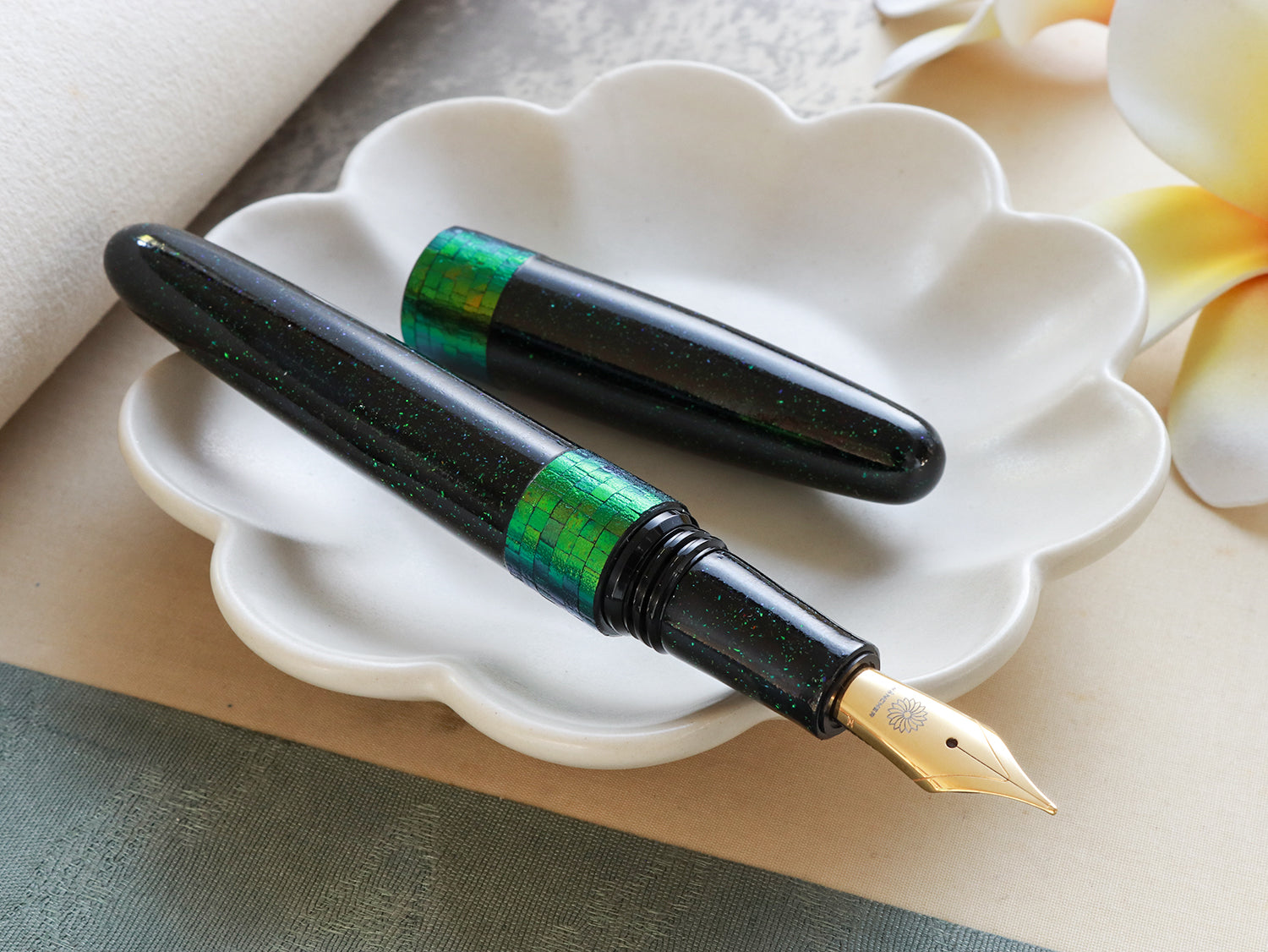

Techniques of Tamamushi Wing Maki-e

The outer wings of Tamamushi beetles, which are living jewels, are finely carved to fit on the curved surface of the fountain pen. Small pieces of the same brilliance are carefully adhered one by one by craftsmen. The Maki-e technique is applied by sprinkling gold and silver powder on the surface of the pen while the lacquer is still wet.
The challenging part lies in fixing the wings of jewel beetles into a fountain pen because it contains a lot of oil that hinders the sticking process. Only highly skilled artisans can put together the jewel beetle's wing and Opal pieces onto the black fountain pen, like an enchanted sight of the aurora and twinkling stars in the night sky.
The outer wings of Tamamushi beetles, which are living jewels, are finely carved to fit on the curved surface of the fountain pen. Small pieces of the same brilliance are carefully adhered one by one by craftsmen. The Maki-e technique is applied by sprinkling gold and silver powder on the surface of the pen while the lacquer is still wet.

The challenging part lies in fixing the wings of jewel beetles into a fountain pen because it contains a lot of oil that hinders the sticking process. Only highly skilled artisans can put together the jewel beetle's wing and mother-of-pearl (Raden) pieces onto the black fountain pen, like an enchanted sight of the aurora and twinkling stars spread in the night sky.
Why we chose Tamamushi wing maki-e technique
During the Asuka period, when the 'Tamamushi Zushi' was made, the brilliance of Tamamushi (jewel beetles) was something that only rich nobles could appreciate.
We thought of bringing the brilliance of both auroras and jewel beetles, which amazed the two nobles of the Asuka period, Empress Suiko and Prince Shotoku.
Also, we long for the iridescent colors of Tamamushi to be reflected in the design of our fountain pen and can be enjoyed in this modern era.
As we have mentioned before, 'Tamamushi Zushi' is the inspiration behind the Tamamushi wing Makie pen, and it was designated a national treasure in 1951. In the past, Empress Suiko (554 - 628), who ordered to make the Zushi, loved the beautiful glow of the Tamamushi design, and she kept it in her palace. Prince Shotoku, who governed the political affairs as a regent for Empress Suiko, also remarked on the Tamamushi design, "an appearance of aurora whose shape was like a tail of a peasant." WANCHER thought of bringing the brilliance of both aurora and jewel beetles, which made two nobles of the Asuka period, Empress Suiko and Prince Shotoku, which could be reflected in the design of the fountain pen.











 Packaging
Packaging